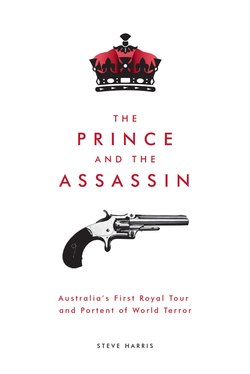Читать книгу The Prince and the Assassin - Steve Harris - Страница 6
На сайте Литреса книга снята с продажи.
ОглавлениеINTRODUCTION
The two guns sat comfortably in the palm of each hand. Alfred Albert’s eyes took in every small detail of their blue nickel finishes, triggers and barrels. He instinctively felt the weight of the Colt ‘navy’ pistol and the Smith and Wesson ‘old army’ revolver, perhaps surprised by their relative lightness.
Through his service in the British Navy he was not unfamiliar with weaponry, but this was personal. He was a central figure in the story they represented, one with threads running through the reach and rule of the British Empire, the reign and influence of Queen Victoria, the future of Empire and Royalty in the face of republican pressures in places like Ireland and Australia, and man’s eternal conflicts over matters of national security, law, religion and politics.
As he fingered the old American Civil War weapons, Alfred might have appreciated they, like him, had come together at Sydney Harbour from the other side of the world, each in the name of security, but then come to be front and centre of the biggest crime in Australia’s young history and a ‘reign of terror’ in the world’s most remote land.
The guns were two of the thousands, favoured by Colonel Samuel Colt, Indian fighter General George Custer and frontiersman James Butler (‘Wild Bill’) Hickok, which had been abandoned after the Civil War, and imported into the frontier of an emerging Australia for use by gold-diggers, farmers and constables.
Two of them, sold as ‘righteous’ rather than cheap copies, were procured by a young man who had crossed the world as an immigrant with a family pursuing religious and political freedom, and been knocking on the door of becoming an ordained priest. Henry O’Farrell had a crucifix in his pocket, but procured the guns because he had another calling in his mind, an Englishman called Alfred.
It was almost 100 years since another English naval officer, Captain James Cook first planted a flag in the sandy shoreline of Terra Nullius to claim the newest and most distant addition to the British Empire. Queen Victoria had despatched her favourite son, Prince Alfred Ernest Albert, to undertake a Royal journey unequalled, before or since, in distance and duration, with a threefold agenda: to reinforce the Britishness and loyalty of those who had been transported, freely as migrants or compulsorily as convicts; to shore up a devotion to the Crown and Empire in the face of any republican ambitions; and to try to ensure Alfred remained trouble-free and thus a bona fide spare and acceptable heir should his elder brother Edward continue to demonstrate an unsuitability to be King.
Alfred was barely interested in the political machinations of Windsor Castle and the Admiralty, barely tolerant of the pomp and protocols of being a Royal, and hardly fussed about matters of State and Empire. His appetite was for the joy of hunting and gambling during the day, and the carousing pleasures of the night, away from the repressive eye of his mother.
And as far away as anyone could be from his mother’s eye, Alfred cared little for whatever anyone in London thought of the political success of his historic Royal tour, or what the colonial administrators and citizenry of Australia thought of his behaviour.
But now, the visit over, standing in his wood-panelled cabin on HMS Galatea inspecting the Civil War guns, Prince Alfred knew that the story behind the guns would be the talk of the Empire, ensure his voyage was seen as one of triumph, and he would be able to dine out on the tale for many a soirée.
A minute of madness at Clontarf on Sydney Harbour had instantly transformed Australia from unprecedented joy to unprecedented anger and moral panic, rocked to its foundations by the shame of the most serious assassination attempt on a member of the Royal family.
The shooting ignited the first experience of the fear of international political terror, of being at the front-line of a new global criminal conspiracy to overthrow colonial rule. It unleashed treason against security, justice against vengeance, self-interest against public interest, martyrdom against madness, religion against law, colonial masters against local administrators, truth against deceit.
This is the story of Alfred Albert and Henry O’Farrell, and how their worlds and lives collided in that moment of madness, and the story of the reverberating passions and forces which followed, some of which are still being felt.
